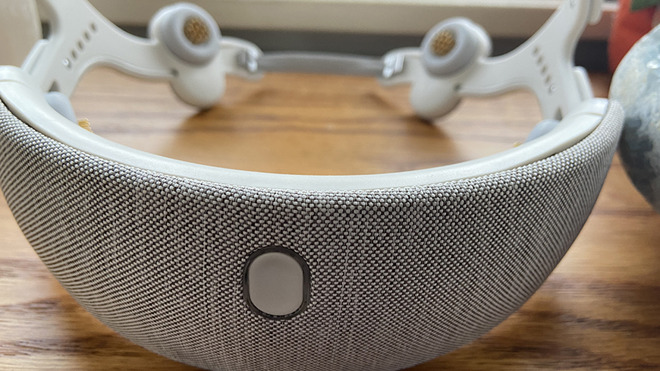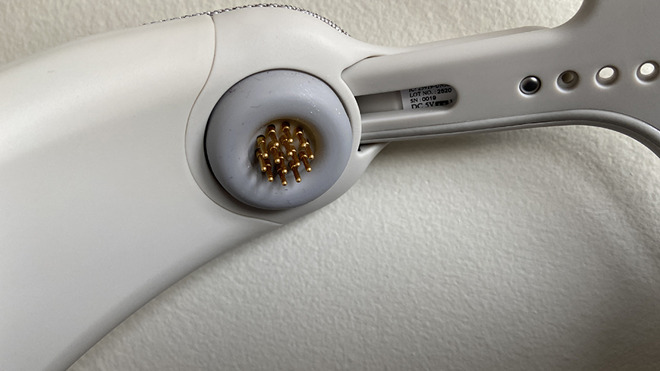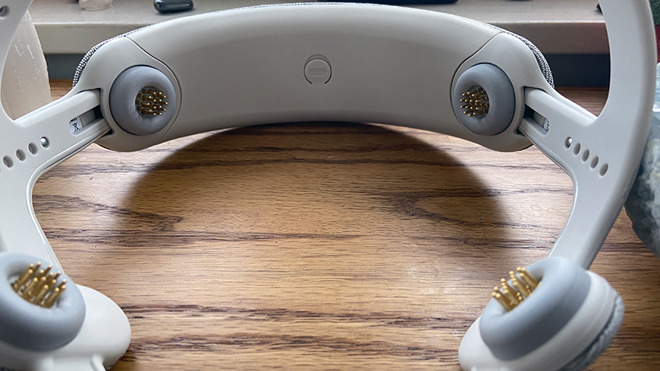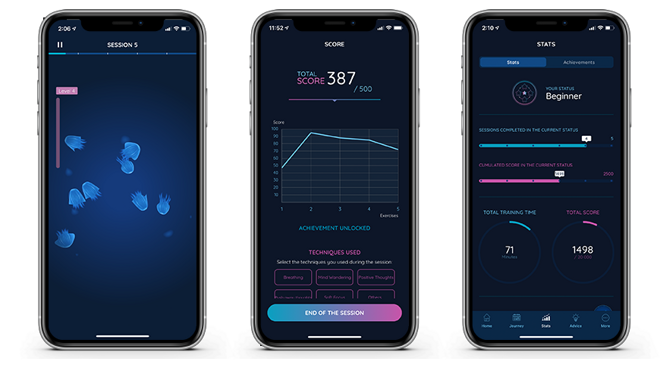UrgoNight review: retrain your brain to help you sleep better
The UrgoNight brain-training headband could help you improve your sleep patterns, but it may take a few weeks to see any results.

If you suffer from sleep problems, you should know that you're not alone -- poor quality sleep is a common problem. The Sleep Foundation points out that 30% of adults in the United States complain about sleep disruption, while 10% have daytime functional impairment consistent with insomnia.
For many people, that translates to taking over-the-counter or prescription sleep medication that often becomes less effective over time.
UrgoNight aims to change that with a drug-free solution. By combining a brainwave-reading headband with an app, UrgoNight teaches you how to bring your brainwaves into proper alignment to promote more restful sleep.
Instead of relying on medication to induce drowsiness, UrgoNight helps you learn how to fall asleep naturally.

Electrodes on the UrgoNight that touch your scalp and skin
If you have short hair, you'll likely be able to put on the device and simply start training. However, our test unit's two primary testers have especially thick hair, which requires a considerable amount of fussing to get it to sit correctly.
Additionally, we found that it was more effective for one tester than it was for the other. One person was reported to have a considerable amount of what the app refers to as "noise" when using it, even when it was fitted up properly, while the other had no issues.
To combat these issues, the makers of UrgoNight offer a service where they coach you on how to wear the device properly, which will likely be helpful for most people. That being said, as this is a device to be worn on your head, there's a chance that your mileage may vary.
Keeping that in mind, we also didn't have a problem just leaving it plugged in on the bedside stand, either. Unless outlet space is at a premium in your house, chances are you'll probably just keep it plugged in when not in use.
Training yourself to create these waves has been shown to decrease anxiety and depression, increase memory and focus, and of course -- improve sleep quantity and quality.
Neurofeedback training isn't exclusive to UrgoNight, either. Neurologists have been helping people train their brainwaves through similar systems since the late 1960s.
Like professional systems, UrgoNight trains your brain through gamification of brainwave patterns. UrgoNight shows you a "game" of sorts -- a bit of visual feedback that you focus on -- that you'll be asked to complete.
For example, UrgoNight may show you a cluster of jellyfish. When you successfully produce SMR waves, UrgoNight will remove a jellyfish. The goal? Remove as many jellyfish as possible by stimulating SMR wave productions.
The downside is that, because it is self-directed, you'll have to figure out how to produce these brainwaves on your own. It takes a bit of trial and error, and if you find yourself getting too distracted, you might wind up with a training session feeling wasted.

View of the four electrode bunches on the interior of the UrgoNight headband
Still, if you stick with it, you should be able to figure out how to produce these waves on command.
We do have a few tips for those who are starting out with UrgoNight that may help speed things along.
For the most part, users will need to open the app, complete a training lesson, and then go about their day.

The UrgoNight companion app.
The training sessions last about 20 minutes, and feature a 12-hour cool down between sessions. You open up the app, tap on the daily session, do a quick eyes-closed calibration, and then launch straight into the training activity.
When completed, UrgoNight gives you a score and allows you to record any notable things you learned. After you're done, the next training session is locked for 12 hours.
The UrgoNight app requires iOS 11.0 or later, and is compatible with the iPhone, iPad, and iPod touch.
In fact, the tester who completed more testing and had a higher average testing score saw less notable improvement over the one who tested less often with lower scores.
Our best guess is that one tester may already naturally produce SMR waves at a greater quantity than the other. Because of this, their improvement was less noticeable than the other.
You'll need to be very consistent with it -- UrgoNight suggests that it'll take up to 20 sessions before you see results. As you can only complete one session every 12 hours, you'll need to spend some serious time investment before you see any meaningful improvement to your sleep quality.
Should you be interested in trying UrgoNight for yourself, you can head to UrgoNight's website and pick one up for $499.00 -- while expensive, UrgoNight is one of the only at-home SMR training systems available directly to consumers.

If you suffer from sleep problems, you should know that you're not alone -- poor quality sleep is a common problem. The Sleep Foundation points out that 30% of adults in the United States complain about sleep disruption, while 10% have daytime functional impairment consistent with insomnia.
For many people, that translates to taking over-the-counter or prescription sleep medication that often becomes less effective over time.
UrgoNight aims to change that with a drug-free solution. By combining a brainwave-reading headband with an app, UrgoNight teaches you how to bring your brainwaves into proper alignment to promote more restful sleep.
Instead of relying on medication to induce drowsiness, UrgoNight helps you learn how to fall asleep naturally.
Comfort and ease of use
There's a learning curve with the UrgoNight, and we wouldn't call it a comfortable experience, as when worn correctly, the device doesn't hurt, but it's noticeable. The electrodes on the device can also be a little scratchy and tug at your hair or scratch at your skin when you first put it on.
Electrodes on the UrgoNight that touch your scalp and skin
If you have short hair, you'll likely be able to put on the device and simply start training. However, our test unit's two primary testers have especially thick hair, which requires a considerable amount of fussing to get it to sit correctly.
Additionally, we found that it was more effective for one tester than it was for the other. One person was reported to have a considerable amount of what the app refers to as "noise" when using it, even when it was fitted up properly, while the other had no issues.
To combat these issues, the makers of UrgoNight offer a service where they coach you on how to wear the device properly, which will likely be helpful for most people. That being said, as this is a device to be worn on your head, there's a chance that your mileage may vary.
Battery life
The manufacturer states that the device should get up to six hours of battery life on a single charge, which works out to about two weeks of recommended use, but we didn't find that to be the case. At a maximum, we saw three hours of battery life before it needed a recharge.Keeping that in mind, we also didn't have a problem just leaving it plugged in on the bedside stand, either. Unless outlet space is at a premium in your house, chances are you'll probably just keep it plugged in when not in use.
The UrgoNight system, explained
UrgoNight works by training you to learn how to produce sensorimotor rhythm (SMR) brainwaves. SMR waves are low-beta waves associated with alert calmness.Training yourself to create these waves has been shown to decrease anxiety and depression, increase memory and focus, and of course -- improve sleep quantity and quality.
Neurofeedback training isn't exclusive to UrgoNight, either. Neurologists have been helping people train their brainwaves through similar systems since the late 1960s.
Like professional systems, UrgoNight trains your brain through gamification of brainwave patterns. UrgoNight shows you a "game" of sorts -- a bit of visual feedback that you focus on -- that you'll be asked to complete.
For example, UrgoNight may show you a cluster of jellyfish. When you successfully produce SMR waves, UrgoNight will remove a jellyfish. The goal? Remove as many jellyfish as possible by stimulating SMR wave productions.
The downside is that, because it is self-directed, you'll have to figure out how to produce these brainwaves on your own. It takes a bit of trial and error, and if you find yourself getting too distracted, you might wind up with a training session feeling wasted.

View of the four electrode bunches on the interior of the UrgoNight headband
Still, if you stick with it, you should be able to figure out how to produce these waves on command.
We do have a few tips for those who are starting out with UrgoNight that may help speed things along.
- Don't train while you are particularly tired-- SMR waves are associated with alertness
- Wear comfy, non-restrictive clothing
- If you have long hair, be sure to tie it back before starting
- If you have thick hair, use the built-in noise assessment to ensure the UrgoNight electrodes can properly read your brainwave activity. You may need to fuss with it more than you think
- When possible, do your training in isolation-- kids and pets can break your focus and lower your score
The App
The app is straight forward and walks you through how to use it -- as well as the UrgoNight headband -- on the first use. There aren't a lot of bells and whistles, though there needn't be, either.For the most part, users will need to open the app, complete a training lesson, and then go about their day.

The UrgoNight companion app.
The training sessions last about 20 minutes, and feature a 12-hour cool down between sessions. You open up the app, tap on the daily session, do a quick eyes-closed calibration, and then launch straight into the training activity.
When completed, UrgoNight gives you a score and allows you to record any notable things you learned. After you're done, the next training session is locked for 12 hours.
The UrgoNight app requires iOS 11.0 or later, and is compatible with the iPhone, iPad, and iPod touch.
Effectiveness
This was a bit of a mixed bag-- one person who used it had excellent results, while the other saw mild to moderate sleep quality improvement. Both testers have completed a minimum of 20 sessions, though session quantity and session score did not correlate to improved sleeping.In fact, the tester who completed more testing and had a higher average testing score saw less notable improvement over the one who tested less often with lower scores.
Our best guess is that one tester may already naturally produce SMR waves at a greater quantity than the other. Because of this, their improvement was less noticeable than the other.
Overall
The UrgoNight is an excellent concept, though it may not be for everyone. If you're looking for a drug-free way to increase your sleep quality or lower anxiety levels, it's an excellent device to try out.You'll need to be very consistent with it -- UrgoNight suggests that it'll take up to 20 sessions before you see results. As you can only complete one session every 12 hours, you'll need to spend some serious time investment before you see any meaningful improvement to your sleep quality.
Should you be interested in trying UrgoNight for yourself, you can head to UrgoNight's website and pick one up for $499.00 -- while expensive, UrgoNight is one of the only at-home SMR training systems available directly to consumers.
Rating: 3.5 stars out of 5
Pros- App is easy to use
- Very effective for some of our testers
- Fitting the headband properly can be difficult
- Some users may not be able to wear the headband as effectively as others
- Can be difficult to use if you have long or particularly curly hair

Comments
But it's odd that there's no mention of any data from the device being sent to Apple's HealthKit API. It may not use Apple's HealthKit. This omission should have been mentioned since this is an Apple-centric website.